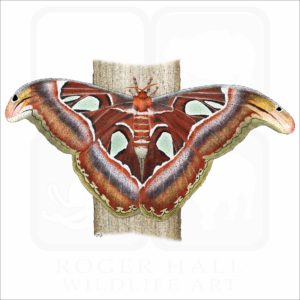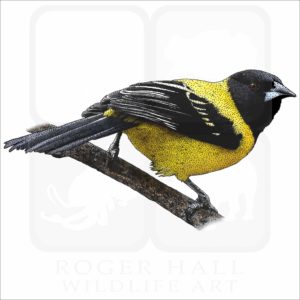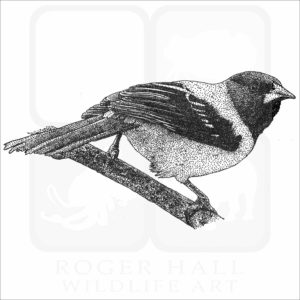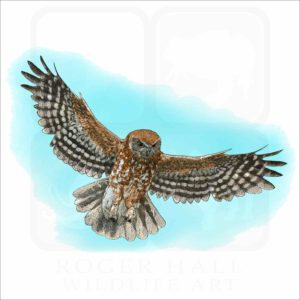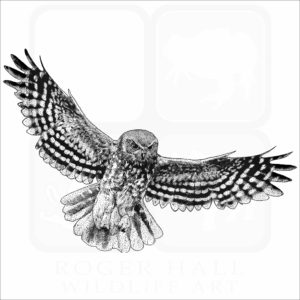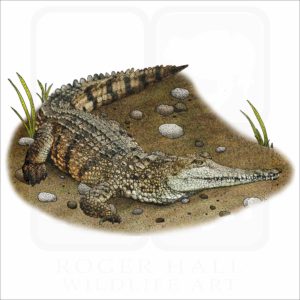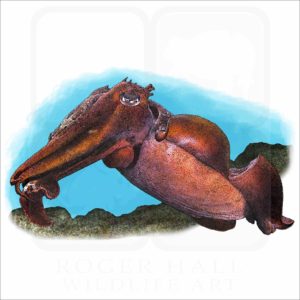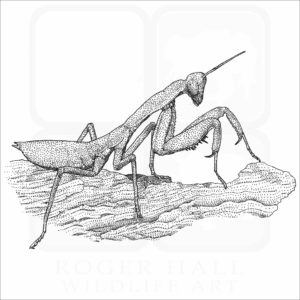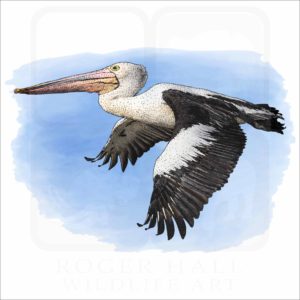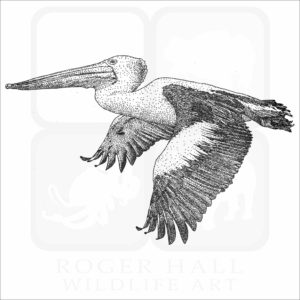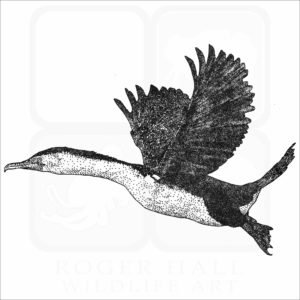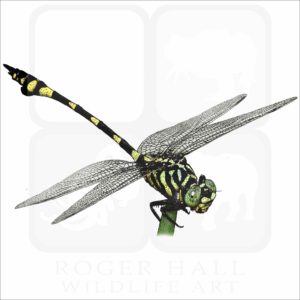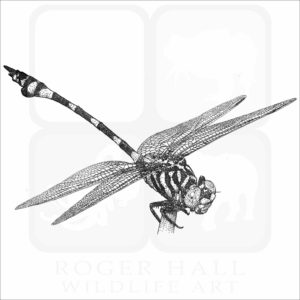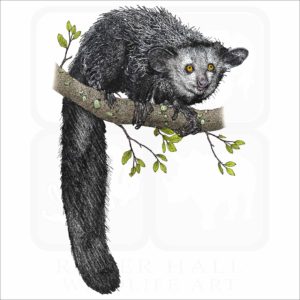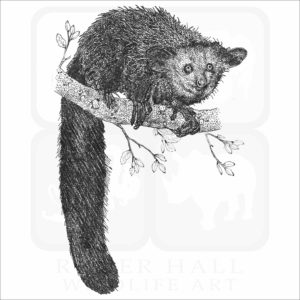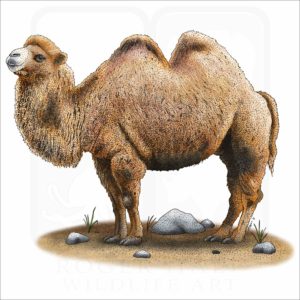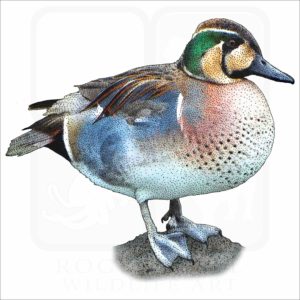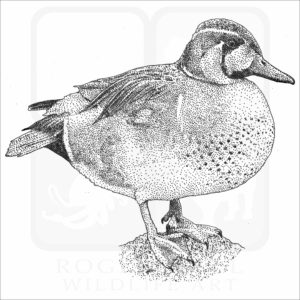Atlas Moth – Signed Fine Art Print
Information about the Atlas Moth:
The Atlas Moth is is a large flying insect found in the tropical and subtropical forests of Southeast Asia. They has the largest wing surface area of all moths - but not the longest wings - which are generally 10-12 inches. The females are larger than the males. Like some other moths Atlas moths do not eat their entire adult life. The cocoons of the Atlas Moths are used to make a durable silk called "Fagara Silk" The poster is printed on matte, museum-quality paper with Giclée printing quality: • Paper thickness: 10.3 mil • Paper weight: 5.6 oz/y² (192 g/m²) • Opacity: 94% Buy a Digital Download
Select options
This product has multiple variants. The options may be chosen on the product page
Audubon’s Oriole – Signed Fine Art Print
Fine art illustration of an Audubon's Oriole (Icterus graduacauda.)
The poster is printed on matte, museum-quality paper with Giclée printing quality:
• Paper thickness: 10.3 mil • Paper weight: 5.6 oz/y² (192 g/m²) • Opacity: 94% Buy a Digital Download
Select options
This product has multiple variants. The options may be chosen on the product page
Australian Boobook Owl – Signed Fine Art Print
Fine art illustration of an Australian Boobook Owl (Ninox boobook.)
The poster is printed on matte, museum-quality paper with Giclée printing quality:
• Paper thickness: 10.3 mil • Paper weight: 5.6 oz/y² (192 g/m²) • Opacity: 94% Buy a Digital Download
Select options
This product has multiple variants. The options may be chosen on the product page
Australian Freshwater Crocodile – Signed Fine Art Print
Fine art illustration of an Australian Freshwater Crocodile (Crocodylus acutus.)
The poster is printed on matte, museum-quality paper with Giclée printing quality:
• Paper thickness: 10.3 mil • Paper weight: 5.6 oz/y² (192 g/m²) • Opacity: 94% Buy a Digital Download
Select options
This product has multiple variants. The options may be chosen on the product page
Australian Giant Cuttlefish – Signed Fine Art Print
Information about the Australian Giant Cuttlefish:
The Australian Giant Cuttlefish - also simply called the Giant Cuttlefish - is the largest cuttlefish in the world's oceans. They're native to the warm tropical waters off the coastline Western Australia. They tend to be found in and around the rocky reefs, seagrass beds and muddy seafloors up to a depth of 300 feet (100 meters.) They are carnivorous, opportunistic and voracious predators who feed predominantly on crustaceans and fish. This cephalopod has been declared as "Near Threatened." Intense fishing in one location has resulted in massive local population declines. The poster is printed on matte, museum-quality paper with Giclée printing quality: • Paper thickness: 10.3 mil • Paper weight: 5.6 oz/y² (192 g/m²) • Opacity: 94% Buy a Digital Download
Select options
This product has multiple variants. The options may be chosen on the product page
Australian Pelican – Signed Fine Art Print
Fine art illustration of an Australian Pelican (Pelecanus conspicillatus.)
The poster is printed on matte, museum-quality paper with Giclée printing quality:
• Paper thickness: 10.3 mil • Paper weight: 5.6 oz/y² (192 g/m²) • Opacity: 94% Buy a Digital Download
Select options
This product has multiple variants. The options may be chosen on the product page
Australian Pied Cormorant – Signed Fine Art Print
Fine art illustration of an Australian Pied Cormorant (Phalacrocorax varius.)
The poster is printed on matte, museum-quality paper with Giclée printing quality:
• Paper thickness: 10.3 mil
• Paper weight: 5.6 oz/y² (192 g/m²)
• Opacity: 94%
Buy a Digital Download
Select options
This product has multiple variants. The options may be chosen on the product page
Australian Tiger Dragonfly – Signed Fine Art Print
Fine art illustration of a Australian Tiger Dragonfly (Ictinogomphus australis.)
The poster is printed on matte, museum-quality paper with Giclée printing quality:
• Paper thickness: 10.3 mil
• Paper weight: 5.6 oz/y² (192 g/m²)
• Opacity: 94%
Buy a Digital Download
Select options
This product has multiple variants. The options may be chosen on the product page
Aye-Aye – Signed Fine Art Print
Information about the Aye-Aye:
The Aye-Aye is a strepsirrhine primate native to Madagascar. It's the world's largest nocturnal primate. It is the is the only extant member of the genus Daubentonia and family Daubentoniidae. This unusual looking animal combines rodent-like teeth and a specialy adapted thin middle finger. It fills a similar ecological niche as the woodpecker. The Aye-Aye is characterized by its unusual method of finding food; it taps on trees to find grubs, then gnaws holes in the wood using its forward slanting incisors to create a small hole in which it inserts its narrow middle finger to pull the grubs out. This foraging method is called percussive foraging. The only other animal species known to find food in this way is the striped possum. Due to habitat loss - as well as the native peoples seeing the animal as a bad omen and symbol for death causing them to kill them out of superstition - the Aye-Aye is classified as endangered. The poster is printed on matte, museum-quality paper with Giclée printing quality: • Paper thickness: 10.3 mil • Paper weight: 5.6 oz/y² (192 g/m²) • Opacity: 94% Buy a Digital Download
Select options
This product has multiple variants. The options may be chosen on the product page
Bactrian Camel – Signed Fine Art Print
Information about the Bactrian Camel:
The Bactrian Camel is a large, even-toed ungulate native to the cold, barren steppes of Central Asia. While the species has been widely domesticated and there are thought to be over 1,000,000 on the planet, there are only small, isolated populations in remote areas of the Gobi Desert that are wild. The IUCN has the Bactrian Camel on their Red List, and it is considered critically endangered. This camel is liklely the ancestor of all domestic two-humped camels. It is well adapted to the harsh conditions of the Gobi Desert, which is one of the driest, coldest places on earth. These camels can survive through droughts and when food is extremely scarce. Camels are the only land animals that can drink salt or brackish water with no ill effects. The poster is printed on matte, museum-quality paper with Giclée printing quality: • Paper thickness: 10.3 mil • Paper weight: 5.6 oz/y² (192 g/m²) • Opacity: 94% Buy a Digital Download
Select options
This product has multiple variants. The options may be chosen on the product page
Baikal Teal – Signed Fine Art Print
Fine art illustration of a Baikal Teal or Bimaculate or Squawk Duck (Sibirionetta formosa.)
The poster is printed on matte, museum-quality paper with Giclée printing quality:
• Paper thickness: 10.3 mil
• Paper weight: 5.6 oz/y² (192 g/m²)
• Opacity: 94%
Buy a Digital Download
Select options
This product has multiple variants. The options may be chosen on the product page

